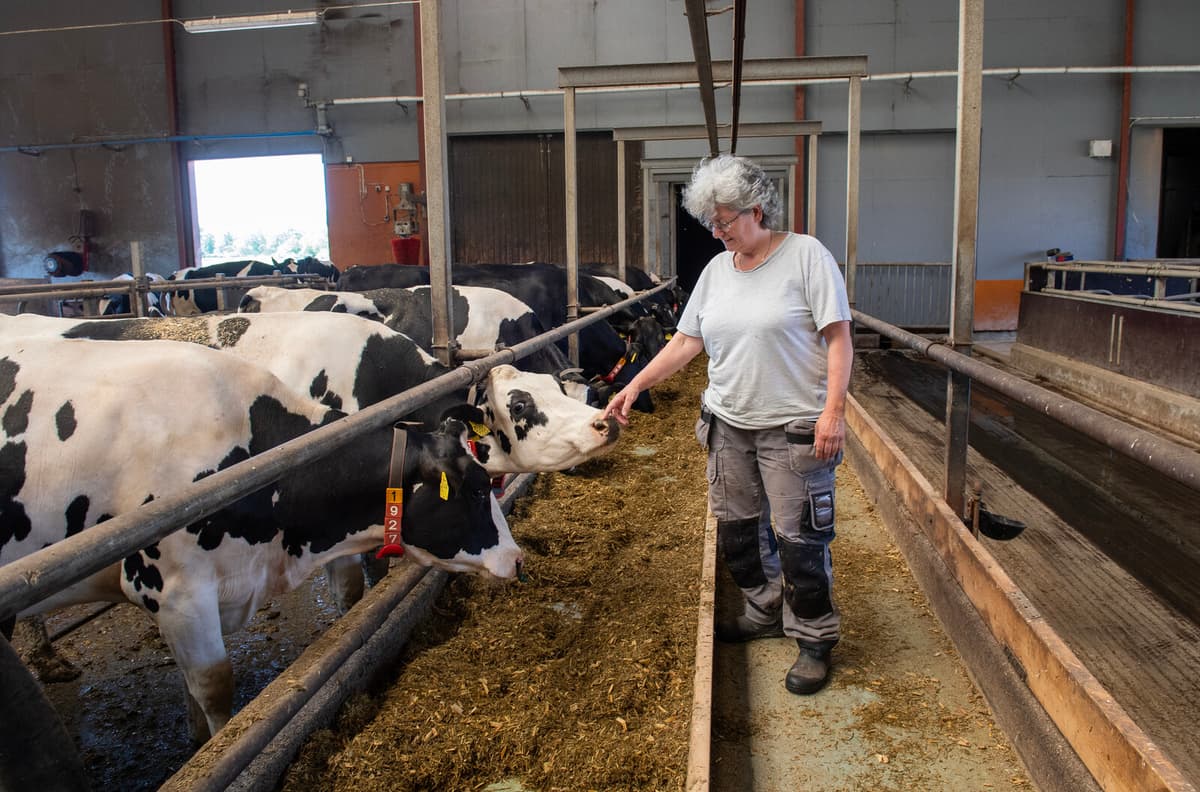Outside the barn lies newly harvested lush grass in large piles that Ingrid's son Johan is shoveling away with a tractor in the scorching summer sun. It will become feed for the approximately 290 animals on the Svånö farm outside Västerås – including around 135 dairy cows.
Since 1998, the farm has grown organic crops and delivered organic milk through Arla. But recently, they switched to conventional farming. Ingrid used to be able to find large shelves with eco-products in food stores, but now she has to search for the products.
Then you realize that they don't sell as much. It was about to starve out us eco-farmers. Someone has to quit so that those who continue can continue economically. We are not farmers just because it's fun or a calling, she says, who in 1983 took over the farm from her parents, together with her husband Henrik.
They are not alone. Last year, the number of organically kept animals among all animal species decreased, according to the Swedish Board of Agriculture's figures.
”The air went out”
Ingrid sits in work clothes on a picnic bench by the dusty gravel plane outside the barn. Over the years, she has seen how their choice has followed social changes – during the 2010s, eco-sales increased.
You were almost a little hero when you grew eco for a while. Consumers and society lifted you up to the skies.
The peak years for organic animal husbandry were for each animal species sometime between 2016 and 2021. But then the figures dropped. Such low figures as in 2024 are only found in 2015 or further back.
The same annual decrease since 2021 is seen in the purchasing pattern. Organic food decreased by 1.5 percent last year and was 6.7 percent of the market, according to the Organic Annual Report.
Ingrid does not think it's about lost credibility. Instead, she points to the economic situation. At the same time, she notes that the classic consumers are people with larger margins – who have presumably stopped shopping because they can afford other parts of their lifestyle.
The air went out. It was when the interest rates rose after the pandemic. People are not willing to pay more for food, because they think food is expensive already.
She understands if consumers have a hard time seeing the difference with organic, and that the active choice is not made in everyday life. Moreover, it is difficult for eco-farmers to highlight their advantages without the others wanting to defend themselves, she means.
For the conventional farmer is no environmental villain. And doesn't want to appear as that either.
The son wanted to change
Even before the sales figures dropped, the number of companies with organic animal husbandry began to decrease, in 2018 and 2019. Ingrid saw how farmers stopped with animals the dry summer of 2018. During the past dry spring, she was afraid of a repeat – because even if milk and meat prices have increased, much is eaten up by things like interest costs.
We need to have periods where we make good money to be able to afford 2018, which was a really bad year.
Husband Henrik's place as co-owner has been replaced by son Johan, who does not see a return to organic with today's regulations.
Since the son is about to take over this, with all due respect, we can't bother him. He gets to steer that. It's his future, it's not ours. We are full-time pensioners, both me and Henrik, says Ingrid.
She agrees that the rules for eco-farmers are both time-consuming and inhibiting. But she thinks they must be clear.
There must be a difference, otherwise there is no reason at all. But at the same time, conventional farming is following. It's becoming more climate-smart, animal-friendly, and better all the time. Then eco has to move on, because in the end they are so close.
Some working methods remain
Pregnant cows have gathered in a pasture by the gravel plane and moo after a cow that calved the day before. She is now spending time with the calf in an enclosure with a straw bed in the barn. In organic animal husbandry, the calf should have at least one day with the mother – in conventional, they can be separated directly.
We have exactly the same as before, one day. Because I want the cow to be in a box for one day and I want the cow to take care of its calf, says Ingrid.
Despite the shift, they have retained some working methods. At the same time, they have adopted others, such as giving deworming medicine as a precaution. According to Ingrid, the cows notice no difference and it was a bigger change when they switched from tied-up cows to loose housing in the barn.
At lunchtime, when hardly a cloud obscures the high-standing sun, the milking cows have gathered in the barn. The gate to the pastures is open, but instead they lick salt stones and are milked in the automatic machines.
Last year, the proposal to abolish milk cows' right to graze outdoors has been debated heavily. Ingrid thinks the proposal is good. If it weren't a legal requirement, they could have gotten paid for it, she means. She doesn't think animal welfare would deteriorate, for example, she mentions that their farm still needs to have cows out on natural pastures.
We with dairy cows are detailed-controlled, damn it, just like we don't understand what's best for our animals ourselves. It won't be like that with the law that the cows will be kept tied up inside all year.
Tove Christensen/TT
Facts: The difference between organic and conventional animal husbandry
TT
The regulations differ between conventional and organic animal husbandry. Organic animal husbandry can be carried out according to the EU's rules or the somewhat more comprehensive Krav rules.
Plant and animal husbandry must be in balance, and the farm must take greater responsibility for biological diversity on organic farms. The animals should mainly eat self-produced feed, and manure for the fields should mainly come from the farm itself. In conventional farming, artificial fertilizers may also be used.
Calves should be able to nurse for at least one day in organic animal husbandry, while they can be separated directly in conventional. The calves should also have access to colostrum for at least twelve weeks and the opportunity to be outdoors during the summer.
Medicines may not be used for preventive purposes in organic animal husbandry.
In both conventional and organic animal husbandry, the cows eat a lot of roughage and are outdoors during the summer half-year. Roughage is fiber-rich and consists mainly of perennial clover and grass species. In organic animal husbandry, however, they should have more roughage and during the summer half-year, they should get part of their feed needs from grazing.
Source: Ekofakta, Swedish Board of Agriculture





